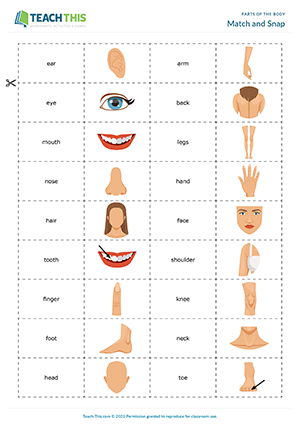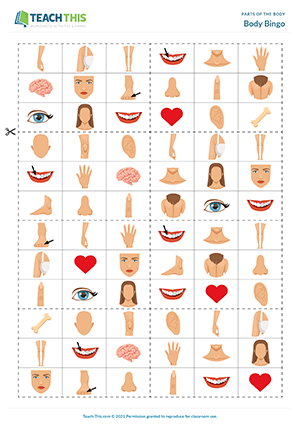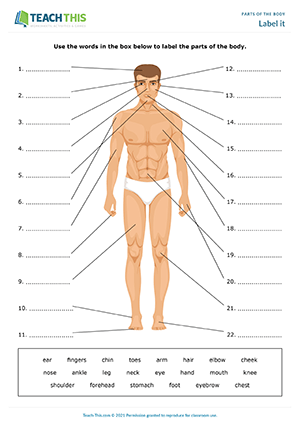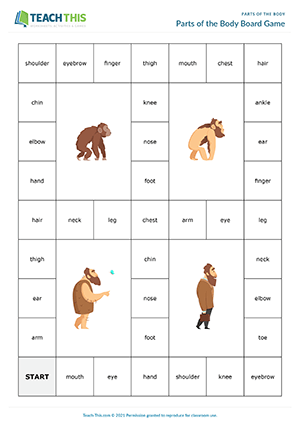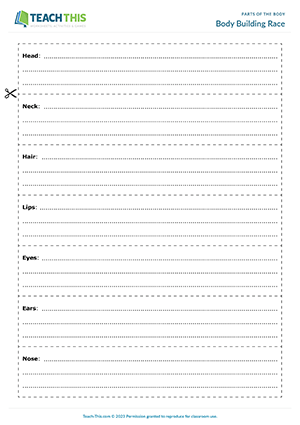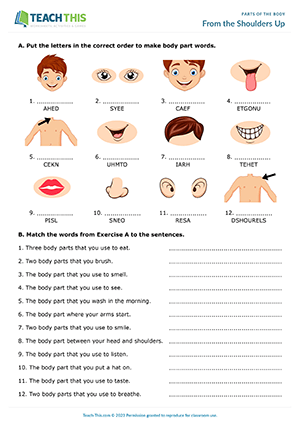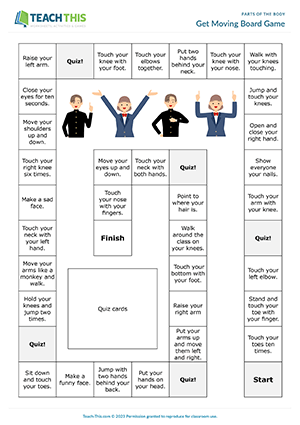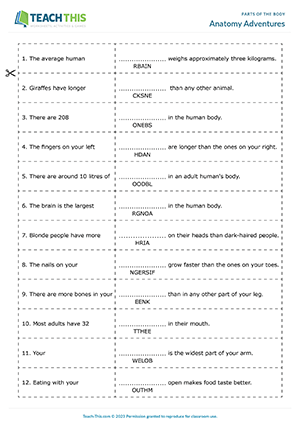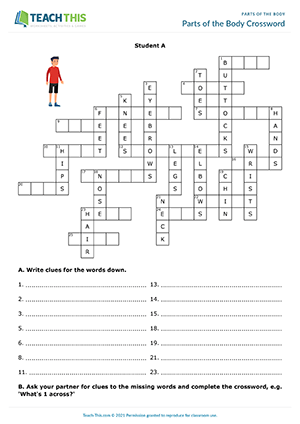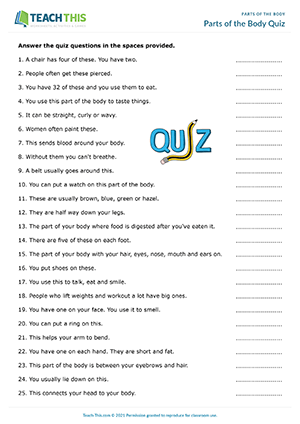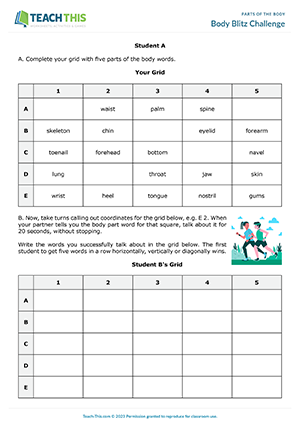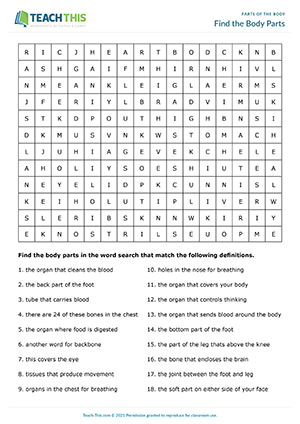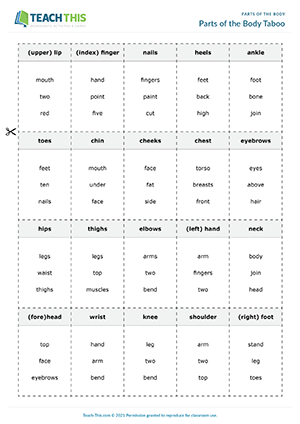These free parts of the body games help students to learn and practice body parts vocabulary. Students begin by playing a parts of the body pelmanism game. In pairs, students take it in turns to turn over one word card and one picture card. The student reads the body part on the word card. If the word matches with the picture, the student keeps the two cards and has another turn. The student with the most pairs of cards at the end of the game wins. Students then move on to play a game of snap with the cards. One student takes the word cards and the other student takes the picture cards. Both students turn over a card from their pile at the same time. If the word card and picture card match, the first student to say 'Snap' scores a point. Students then pick up their own cards, shuffle them and play again. If a student says 'Snap' when the cards don't match, the other student scores a point and the game continues. The first student to get ten points wins the game.
In this enjoyable parts of the body game, students play bingo to practice vocabulary related to body parts. Call out different parts of the body from the caller's sheet in a random order. If students have a matching picture on their bingo card, they cross it off. When a student has crossed off all nine parts of the body, they shout 'Bingo' and read out the body parts. If the body parts are correct, the student wins the round. Play several rounds with students receiving a different bingo card each time.
Here are two useful parts of the body worksheets to help students learn body parts vocabulary. The two worksheets can be used together or separately. With the 'Label it' worksheet, students use words in a box to label parts of the body in a picture. For each correctly labelled item, students score a point. The student with the most points wins. In the 'Draw it' worksheet, students read a description of a monster and draw it in a picture frame. When the students have finished, they compare pictures. Finally, review the description with the class by drawing the monster on the board.
In this fun parts of the body board game, students race against each other to land on word squares in order to be the first student to complete a labelled worksheet indicating 20 parts of the body. Players take it in turns to roll the dice and move their counter along the board in any direction. When a player lands on a word square (e.g. arm), the student looks at their worksheet and labels the appropriate part of the body with that word. The first player to complete their worksheet wins the game.
In this creative body parts game, students describe and guess parts of the body vocabulary and race to draw a body on the board. First, in groups, students invent and write down clues to describe the parts of the body shown on their cards. One student in the group then collects the cards and goes and sits with another team. That student is the reader. The students then play a game where they race to draw a body on the board by guessing body parts from clues. The aim is to draw an accurate body, so body parts must be drawn in the right place. The reader begins by picking up a card and reading out the clue for the body part word. The first student in the group to guess the correct part of the body runs to the board and draws the body part. This continues until all the cards have been used. The first group to correctly guess all 14 body parts and draw an entire body on the board wins the game.
This comprehensive parts of the body worksheet helps students learn and practice vocabulary for body parts above the shoulders. Students begin by unscrambling body part words that correspond to pictures. Students then match the body parts to sentences. Next, students categorise the body part words according to the adjectives that can be used to describe them. After that, students choose the correct body parts to complete facts about the body. Finally, students match sentence halves to make parts of the body-related questions and then ask and answer the questions with a partner.
In this lively parts of the body board game, students practice parts of the body vocabulary by acting out simple instructions and answering quiz questions. In groups, players take turns to roll the dice and move their counter along the board. When a player lands on a square, they act out the command written on the square, e.g. 'Touch your elbows together.' If the player acts out the instruction correctly, they stay on the square. If not, they move back two squares. When a player lands on a quiz square, another student picks up a quiz card and asks the question on the card to the player, e.g. 'Which part of your body can hear?' If the player answers correctly, they stay on the square. If not, they move back. The first player to reach the finish wins the game.
Here are two rewarding parts of the body games to help students practice or review body parts vocabulary. First, students play an unscrambling and matching game. In pairs, students begin by unscrambling body part words on sentence ending cards. Next, pairs line up sentence beginning cards in order and match each one with an ending card. The first pair to complete all their sentences correctly wins. After that, pairs play a true or false game with the sentences. Each pair discusses which sentences they think are true and which they think are false, putting a tick at the end of the sentences that they think are true. Afterwards, check the correct answers with the class. The pair with the most correct guesses wins the game.
In this handy describing parts of the body activity, students complete a crossword by describing and guessing body parts. In two groups, students invent and write down clues for the parts of the body written on their crossword. Students can write clues about the location of the body part, what it looks like or what it's used for. Students then pair up with someone from the other group and take it in turns to ask their partner for a clue to one of their missing words. Their partner reads out the clue for that word and the other student tries to guess the part of the body. If the student guesses the word successfully, they write it on their crossword. If not, their partner continues to give more clues until the student is able to guess the word.
In this free parts of the body quiz game, students answer quiz questions about parts of the body. In pairs, students read quiz questions on the worksheet and write their answers in the spaces provided. Pairs score one point for the correct answer and one point for the correct spelling. The pair with the most points at the end of the game wins.
In this imaginative parts of the body vocabulary game, students talk about different parts of the body for 20 seconds. First, students add five parts of the body to their grid on the worksheet. Students then take turns calling out coordinates for the second grid, e.g. E 2. The other student tells them the corresponding part of the body word for that square and starts timing 20 seconds. The student then talks about the body part for 20 seconds, without stopping. Students can talk about things like the meaning of the word, common health problems associated with the body part, an injury they may have experienced, etc. If the student successfully talks about the body part for 20 seconds, they write the word in the second grid, and the other student crosses the word off their grid. If the student is unsuccessful, they can choose the same word again or pick another grid reference on their next turn. The first student to get five words in a row wins the game.
In this engaging parts of the body word search, students find and match body parts vocabulary to definitions. To begin, students try to find the body parts vocabulary in the word search that matches with the definitions on the worksheet. When a student finds a matching word, they circle it in the word search and write it next to the definition. Students score one point for each correct answer. For an extra point, you can have students show you the location of each body part or make a sentence with the word. The student with the highest score wins.
In this entertaining describing body parts game, students describe parts of the body for a teammate to guess without saying specific words. In competing teams of two, students take it in turns to pick up a card and describe the part of the body in bold to the other student in their team, without saying the body part or using the other words on the card. The student is also not allowed to point or touch the part of the body being described. Each round lasts for 30 seconds. If the other student guesses the body part within the time frame, they score a point for their team. Cards that contain two words (one in brackets) are worth two points, e.g. (upper) lip. If a student guesses only one of the words, they score one point. If the student describing the word makes a mistake or the other student fails to guess the body part, play passes to the other team. The team with the most points at the end of the game wins.
Latest Free
Resources
- Jigsaw Reading
Reading Exam Preparation (B1)
Date Added: 7th of March
- Writing Jeopardy
Writing Exam Preparation (B1)
Date Added: 6th of March
- Present Perfect Bingo
Present Perfect Yes No Questions (A2)
Date Added: 4th of March
- Count on Me!
Making Offers and Promises (A2)
Date Added: 11th of February
- It’s Carnival Time!
Cultural Celebrations (B1)
Date Added: 29th of January
Latest Member
Resources
- Have you done this?
Present Perfect Yes No Questions (A2)
Date Added: 7th of March
- True, False or Not Given
Reading Exam Preparation (B2)
Date Added: 7th of March
- Have you got it?
Present Perfect Yes No Questions (A2)
Date Added: 6th of March
- What have you learned about me?
Present Perfect Yes No Questions (A2)
Date Added: 4th of March
- Have I guessed right?
Present Perfect Yes No Questions (A2)
Date Added: 4th of March



